When it comes to user experience design, accessibility is often an afterthought. But it's the most important aspect of creating truly inclusive design in digital experiences.
As UX designers, creating this digital world is in your hands. Your choices can either open doors or create roadblocks. Accessibility isn’t a bonus feature. It’s a responsibility, and it brings real value to everyone involved.
Accessibility in UX Design means building digital products that anyone can use. It is about comfort, clarity, and equal access. It’s the future of design. In this blog, we'll explore how it benefits both users and businesses.
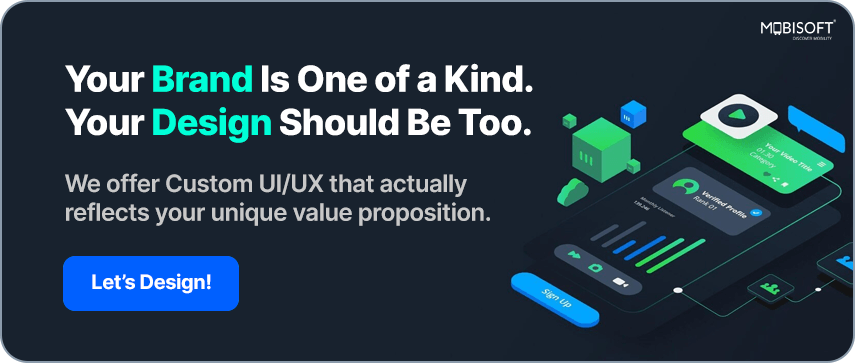
Understanding Accessibility in UX Design
Accessibility is about building inclusive design experiences that work for everyone. It focuses on removing digital barriers so that users with disabilities can fully interact with your product.
Take alt text, for example. It gives users who are blind or visually impaired access to the meaning behind an image through screen readers. Or think about video captions. These help users who are deaf or hard of hearing understand the content.
Accessibility is a basic requirement for inclusive digital experiences.
As we continue to innovate and adopt new technologies, it's also important to consider how AI is transforming UX design and user experience, especially in terms of accessibility enhancements and automation.
Why Designing for Accessibility Matters
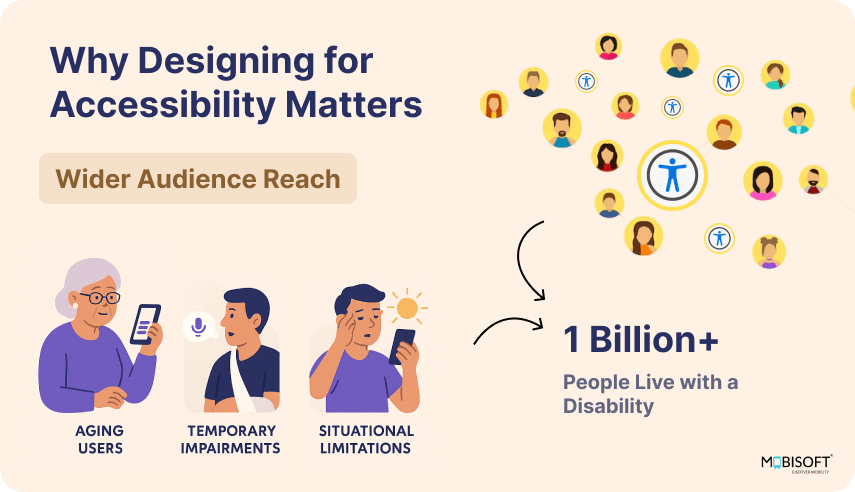
Wider Audience Reach
The biggest benefit of accessibility? More people can use your product.
Over 1 billion people worldwide live with some form of disability. That’s about 15% of the global population, as per the World Health Organization. A product without web accessibility features would give up on an immense audience.
Accessibility goes beyond disability. Think about older adults, someone with a temporary injury, or even users trying to read your app in direct sunlight. Inclusive design helps everyone and is a crucial part of any modern web UI UX design services offering.
Legal Compliance
Accessibility is required by law in many countries. For example, the Americans with Disabilities Act (ADA) in the U.S. mandates digital accessibility. ADA compliance isn’t optional. Non-compliance can result in lawsuits and fines.
The Web Content Accessibility Guidelines (WCAG) provide a clear framework to ensure digital products meet legal and ethical standards.
Improved User Experience for All
Accessibility improves UX. For instance, captions on videos help in noisy places or when watching without sound. Clean, intuitive navigation helps users with cognitive disabilities. It also helps anyone who wants a smoother experience.
When you design for accessibility, you focus on clarity, simplicity, and ease of use. These qualities benefit every user and are often central to UI/UX design services that aim for long-term usability and satisfaction.
SEO Benefits
Accessible websites tend to perform better in search engines. Why? Because accessible design overlaps with SEO best practices.
Features like alt text for images, meaningful headings, and semantic HTML make your site easier for search engines to index. That means more visibility, more traffic, and better engagement.
Brand Reputation and Loyalty
Today’s users care about values. Prioritizing accessible design sends a strong message. It shows that you care about inclusion and equal access for all users.
This not only boosts your brand reputation but also builds loyalty among underserved communities. People remember brands that make everyone feel welcome.
Key Principles to Design Accessible UX
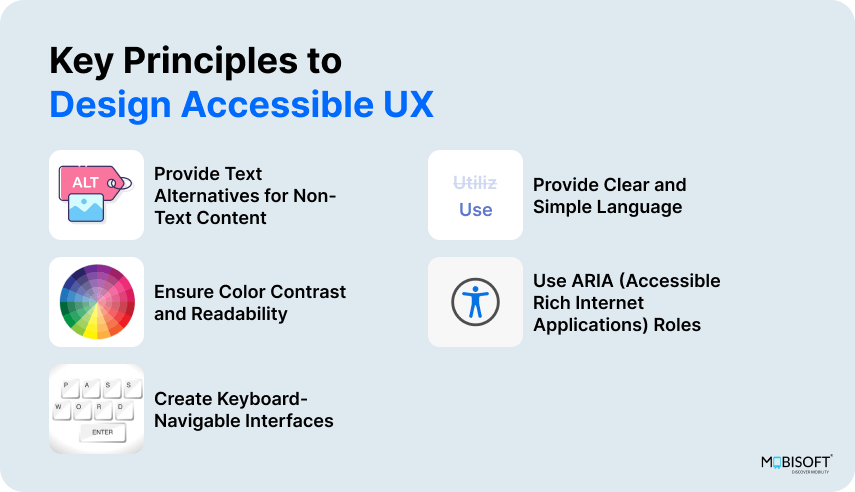
Now that you know why accessibility is essential, let’s look at a few practical ways to build it into your UX process.
Provide Text Alternatives for Non-Text Content
Always add alt text for images, charts, and icons. It allows screen readers to describe visual content to users with vision impairments.
Make your alt text short and specific. Describe the function or content of the image.
Example: Instead of writing “image,” say “A person using a wheelchair in a park.”
Ensure Color Contrast and Readability
Poor contrast can make reading difficult for users with low vision or color blindness. Use a color contrast ratio checker to verify that your text stands out clearly from the background.
WCAG recommends:
- At least 4.5:1 contrast ratio for normal text
- At least 3:1 for large text
Example: Black text on a white background offers a strong contrast. Light gray on white does not.
Create Keyboard-Navigable Interfaces
Many users with motor disabilities can’t use a mouse. They rely on keyboard navigation. Make sure all key elements like buttons, links, and forms are accessible by keyboard.
Users should be able to move easily through the interface using the tab key. Add visible focus states so they always know where they are.
Provide Clear and Simple Language
Use direct language to make your content easy to understand. This is crucial for users with cognitive disabilities in design challenges. It also helps anyone who wants quick clarity.
Avoid jargon. If you must use technical terms, explain them or link to definitions.
Example: Say "use" instead of "utilize" and "start" instead of "initiate."
Use ARIA (Accessible Rich Internet Applications) Roles
ARIA roles make dynamic content and custom components understandable to assistive technology like screen readers. Use them thoughtfully to describe elements like buttons, links, alerts, or tabs.
For example, applying the role="button" attribute helps assistive tech recognize a clickable element that may not be coded as a native button.
Tools to Test Accessibility
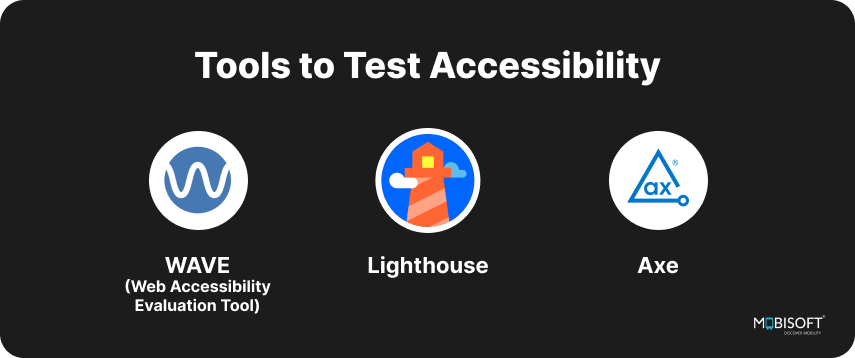
To build accessible products, you need the right accessibility testing tools. These tools help spot issues before they reach users:
- WAVE (Web Accessibility Evaluation Tool): Scans for accessibility errors and suggestions directly on your site.
- Lighthouse: Built into Chrome DevTools, it audits your site’s accessibility along with performance and SEO.
- Axe: A browser extension that quickly identifies accessibility issues with actionable recommendations.
Use these tools regularly as part of your UX accessibility audit process, especially when delivering mobile app design services where accessibility challenges can vary across platforms and devices.
The Bottom Line: Accessibility Isn’t Optional
Accessibility is not just about legal checklists. It is about people. When you make your digital products accessible, you make the online world fairer and more usable for everyone.
You reach more users, improve their user experience, support SEO, and strengthen your brand’s image. Most importantly, you make a real difference.
Building accessibility into your UX design might take extra time and thought. But the payoff is worth it. You create products that welcome everyone. That is the true mark of great design.
As we look to the future of user experience, accessibility will play a critical role in shaping the evolution of UX design: web, app, voice & beyond.
Inclusivity is not just a feature. It is the future.
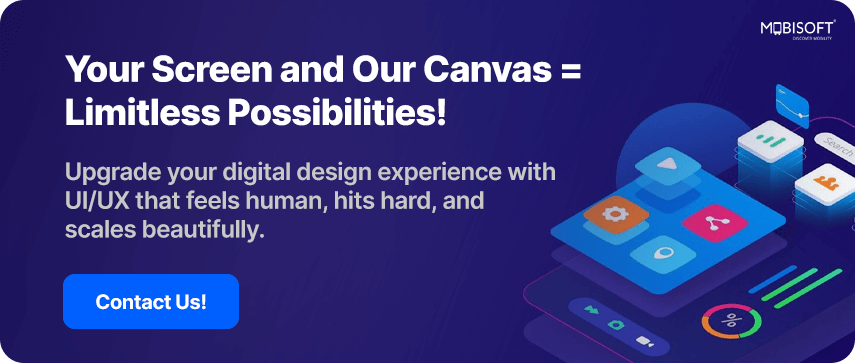

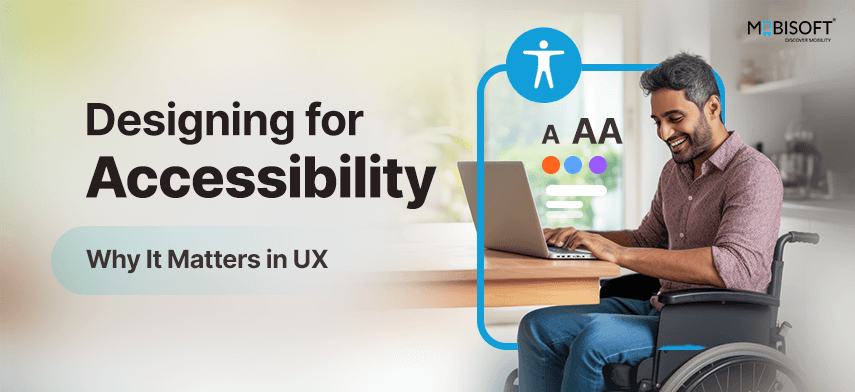


 December 6, 2024
December 6, 2024


